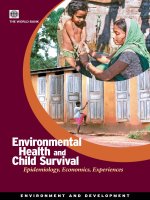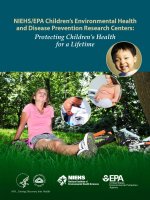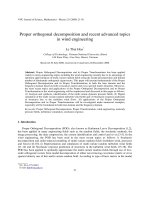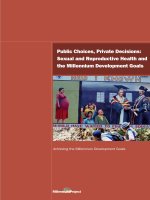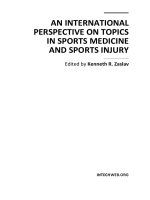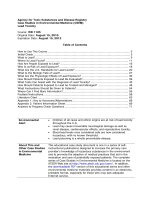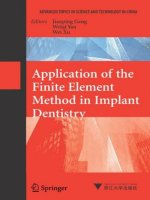ADVANCED TOPICS IN ENVIRONMENTAL HEALTH AND AIR POLLUTION CASE STUDIES ppt
Bạn đang xem bản rút gọn của tài liệu. Xem và tải ngay bản đầy đủ của tài liệu tại đây (29.23 MB, 482 trang )
ADVANCED TOPICS IN
ENVIRONMENTAL HEALTH
AND AIR POLLUTION
CASE STUDIES
Edited by Anca Maria Moldoveanu
Advanced Topics in Environmental Health and Air Pollution Case Studies
Edited by Anca Maria Moldoveanu
Published by InTech
Janeza Trdine 9, 51000 Rijeka, Croatia
Copyright © 2011 InTech
All chapters are Open Access articles distributed under the Creative Commons
Non Commercial Share Alike Attribution 3.0 license, which permits to copy,
distribute, transmit, and adapt the work in any medium, so long as the original
work is properly cited. After this work has been published by InTech, authors
have the right to republish it, in whole or part, in any publication of which they
are the author, and to make other personal use of the work. Any republication,
referencing or personal use of the work must explicitly identify the original source.
Statements and opinions expressed in the chapters are these of the individual contributors
and not necessarily those of the editors or publisher. No responsibility is accepted
for the accuracy of information contained in the published articles. The publisher
assumes no responsibility for any damage or injury to persons or property arising out
of the use of any materials, instructions, methods or ideas contained in the book.
Publishing Process Manager Ivana Lorkovic
Technical Editor Teodora Smiljanic
Cover Designer Jan Hyrat
Image Copyright Thoursie, 2011. Used under license from Shutterstock.com
First published August, 2011
Printed in Croatia
A free online edition of this book is available at www.intechopen.com
Additional hard copies can be obtained from
Advanced Topics in Environmental Health and Air Pollution Case Studies,
Edited by Anca Maria Moldoveanu
p. cm.
ISBN 978-953-307-525-9
free online editions of InTech
Books and Journals can be found at
www.intechopen.com
Contents
Preface IX
Part 1 Environment and Health - New Approach 1
Chapter 1 What is the Minimum Risk that can be
Estimated from an Epidemiology Study? 3
Mark J. Nicolich and John F. Gamble
Chapter 2 Effect of Short-Term Exposure to Near
Highway Pollutants in Motor Vehicle Exhaust
on Inflammation Sensitive Biomarkers 27
Ori Rogowski, Eran Leshem-Rubinow,
Itzhak Shapira and Arie Steinvil
Chapter 3 Application of Neural Net Model to Estimate
the Cardiovascular and Respiratory Diseases by
Air Pollution Data in Urban Area 41
A. Pelliccioni and R. Cotroneo
Chapter 4 Air Pollution and Outpatient Treatment and
Hospital Admissions for Respiratory Diseases
in Children in Southeast Region of Brazil 75
Hermano Albuquerque De Castro, Sandra De Souza Hacon,
Karen Dos Santos Gonçalves and Washington Leite Junger
Chapter 5 Tobacco Smoke Induced Cough: Mechanisms
Driving Acute and Chronic Cough Pathology 97
Megan S Grace, Mark A Birrell, Eric Dubuis and Maria G Belvisi
Chapter 6 Air Pollution, Reactive Oxygen Species (ROS), and
Autonomic Nervous System Interactions Modulate Cardiac
Oxidative Stress and Electrophysiological Changes 121
Elisa Ghelfi
Chapter 7 Acute Effects of Fine Particulate Air Pollution
on Cardiac Electrophysiology 157
Duanping Liao, Michele L. Shaffer and Haibo Zhou
VI Contents
Chapter 8 Carbon Monoxide Urban Air
Pollution: Cardiac Effects 171
G. Meyer, S. Tanguy, P. Obert and C. Reboul
Chapter 9 Application of the Ultramicro Forward-Mutation
Assay to the Monitoring of Indoor and
Outdoor Air Mutagenicity-Examples of
Chengdu City and Tokyo 179
Yukihiko Takagi, Daisuke Nakajima,
Sun Chengjun
and Sumio Goto
Chapter 10 Air Pollution and Urban Morphology:
A Complex Relation or How to Optimize
the Pedestrian Movement in Town 197
Gilles Maignant and Jérôme Dutozia
Part 2 Environmental Case Studies 209
Chapter 11 Air Pollution in Moscow Megacity 211
Gennady Gorchakov, Eugenia Semoutnikova,
Aleksey Karpov and Elena Lezina
Chapter 12 Impact of Urban Air Pollution on Acute
Upper Respiratory Tract Infections 237
Marcos Abdo Arbex, Silvia Leticia Santiago,
Elisangela Providello Moyses, Luiz Alberto Pereira,
Paulo Hilário Saldiva and Alfésio Luís Ferreira Braga
Chapter 13 Air Pollutants and Its Effects on Human Healthy:
The Case of the City of Trabzon 251
Yelda Aydın Türk and Mustafa Kavraz
Chapter 14 Air Pollution and Its Impacts –
The City of Rijeka Case Study 269
Ana Alebić-Juretić
Chapter 15 Air Pollution with Asbestos
in Several Cities in Romania 295
Anca Maria Moldoveanu
Chapter 16 Adverse Effect of Air Pollution on Odor Perception 307
Marco Guarneros, René Drucker-Colín,
José Esquivelzeta and Robyn Hudson
Chapter 17 Distribution of Indoor Concentrations and Emission
Sources of Formaldehyde in Japanese Residences 329
Naohide Shinohara, Atsushi Mizukoshi, Toshiyuki Kataoka,
Koichi Takamine, Masashi Gamo and Yukio Yanagisawa
Contents VII
Chapter 18 Comparison of Indoor and Outdoor
Bioaerosols in Poultry Farming 339
Elżbieta Lonc and Kinga Plewa
Chapter 19 The Occurrence of Bioaerosols in The Food
Preparation Areas of HIV/AIDS Hospices
in Central South Africa 353
J. Nkhebenyane, J. F. R. Lues, P. Venter and K. Shale
Chapter 20 Indoor Air Quality in Primary Schools 361
Maria do Carmo Freitas, Nuno Canha, Maria Martinho,
Marina Almeida-Silva, Susana Marta Almeida, Priscilla Pegas,
Célia Alves, Casimiro Pio, Maria Trancoso, Rita Sousa,
Filomena Mouro, Teresa Contreiras
Part 3 Polluted Environment and Its Influence on
Elderly People Health 385
Chapter 21 Do Socio-Demographic Characteristics Modify
the Association Between Air Pollution and
Mortality & Morbidity? 387
Sabit Cakmak, Sara L. Martin, Claudia Blanco Vidal, Timur
Gultekin, Vladislav Brion and
Maria Angelica Rubio
Chapter 22 Short-Term Exposure to Outdoor Pollutants
and Loss of Pulmonary Function in the Elderly 409
Yun-Chul Hong and Jin Hee Kim
Part 4 Polluted Environment and Its Influence
On Allergic Diseases 417
Chapter 23 Aggravation of Allergic Rhinitis by Air Pollution:
Demonstration by an Animal Model of Pollenosis 419
Takeshi Nabe and Nobuaki Mizutani
Chapter 24 The Impact of Asthma and Allergic Diseases on
Schoolchildren: Are They at Increased Risk of
Absenteeism and Poor School Performance? 435
Abdulbari Bener
Chapter 25 The Effects of Air Pollution on Cellular Material
Release, Allergenicity and Allergens Proteins of
Three Ornamental Plants 453
Farkhondeh Rezanejad and Ahmad Majd
Preface
One of the greatest environmental problems is air pollution. This book provides an
overview on air pollution as well as its impact on human health.
Beginning with the assessment of what the minimum risk that can be estimated from a
study is and trying to find a link between pollution and human health, the book
describes the effects of air pollutants on human physiology. Air pollutants can
influence inflammation biomarkers, can influence the pathogenesis of chronic cough,
can influence reactive oxygen species (ROS) and can induce autonomic nervous
system interactions that modulate cardiac oxidative stress and cardiac
electrophysiological changes, can have impact on morbidity and mortality related to
the cardio-vascular system, can participate in the onset and exacerbation of upper
respiratory diseases, can lead to the exacerbation of asthma and allergic diseases.
Multiple ways of assessing the relation between environment and human health were
described. For example, the Neural Network approach was used to model the relations
between the environment, meteorological data and health effects and to investigate
cardio-respiratory hospitalisations. Possible air pollutants were investigated in
outdoor spaces as well as in indoor spaces like residential homes or primary schools.
The book also presents how the urban environment can influence and modify the
impact of various pollutants on human health. Specific pollution situations are
described in different cities like Moscow, São Paulo, Rijeka, Bucharest, Lisbon, Mexico,
Trabzon-Turkey as well as in different countries like Japan, China, Korea, Israel, South
Africa, Brazil, Chile and Poland and the pollutants involved were: particulate matter,
sulphur dioxide, nitrogen oxides, ozone, carbon monoxide, formaldehyde,
benz(a)pyrene, asbestos, allergens, and biological contaminants.
Several chapters present how indoor air quality may affect the health of children and
elderly people.
One study presents the relation between odor perception and air pollution and the fact
that different aspects of odor perception are altered to varying degrees.
The book is the result of the effort of many experts, from many countries and from
different parts of the world and it shows that the interest in environmental health is
growing.
X Preface
I wish to offer special thanks to the team from InTech Open Access Publisher for their
exceptional assistance.
Assoc. Prof. Anca Maria Moldoveanu MD, PhD,
University of Medicine and Pharmacy “Carol Davila” Bucharest
Romania
Part 1
Environment and Health - New Approach
1
What is the Minimum Risk that can be
Estimated from an Epidemiology Study?
Mark J. Nicolich
1
and John F. Gamble
2
1
Cogimet, Lambertville, NJ
2
Somerset, NJ
USA
1. Introduction
Risk is commonly thought of as related to the chance of suffering a loss. In the following
discussion we formally define risk and show that epidemiology and risk assessment are
related to the probability that a specified event occurs. The risk will be in the form of a relative
risk where the probability of an event occurring under specified conditions is expressed as a
multiplier for the probability of the event occurring at some defined 'background level.'
The goal of the paper is to determine if there is a smallest relative risk that can be
determined. That is, is there a risk level at which we can say 'An estimated risk less than X
cannot be considered different from background level no matter what estimation methods
are used or what the estimated statistical significance level is.' We are assuming the
estimated risk level is based on data from an epidemiological study such as the health
effects of ambient air pollution or arsenic in the public drinking water. We assume that there
is a True Risk Level that applies to a defined population and we wish to estimate it based on
the data from an epidemiology study. We assume the data are statistically analyzed either by
simple ratios of the observed data or by model-based Bayesian or Classical statistical methods.
There are specific epidemiological and statistical considerations that are needed to develop the
formal estimate of the true risk as diagramed in Figure 1.
Figure 1 indicates the flow is from a true, but unknown, risk to a final estimate of the risk. It
could have been shown as a flow from the initial hypothesis, through the design of the
experiment, the analysis of the data, and the final estimate of the true risk. Either structure
can be used, but we have chosen the method shown in Figure 1.
In practice the statistical and epidemiological considerations are not separate and distinct
steps in the estimation process, but are shown and discussed separately for convenience.
The following sections will cover:
Basic Conclusions,
Meaning of relative risk (RR),
Epidemiological considerations in estimating a RR,
Statistical considerations in estimating a RR,
Discussion of how to answer the question “what is the smallest relative risk that can be
determined”?
Conclusion and summary,
An appendix of quotes from knowledgeable researchers in the field
Advanced Topics in Environmental Health and Air Pollution Case Studies
4
True
Risk
Epidemiological
Considerations:
Bias, confounding, etc.
Statistical
Considerations:
Sampling, models, etc.
Estimated
Risk
Fig. 1. Considerations needed to develop the point estimate and the significance level of an
estimated risk.
2. Basic conclusions
There is no minimum estimable risk in the sense that there is no minimum measure of
length. To accurately and precisely measure risk, or length, one needs a tool that is accurate
and precise enough for the measurement being made. For example, a meterstick is
inadequate for measuring length to a precision of 0.1 mm. When measuring risk in
epidemiology, precision and accuracy depend on many factors including the degree to
which the experimental data and analysis are free of the errors associated with experimental
design flaws (i.e. confounding, bias, reliability, measurement error and misclassification,
potential alternate risk factors), and statistical analysis errors (i.e. sampling error, violations
of model assumptions, model shopping, multiple subgroup analyses, reliance on
significance levels or p-values). Indeed, it is theoretically possible to correctly estimate
significant risks near 1.000001 if there were no confounding, no biases, no measurement
error, exact model specifications, etc. But it is unlikely, if not impossible, these conditions
ever exist for an epidemiology study.
While there is no ‘lower bound’ to an estimable risk, and while many experienced researchers
have made opinions about approximate lower bounds, a practical lower limit does exist. To
believe an estimated risk the researchers must demonstrate that they have carefully considered
the array of possible errors that can arise from the tools and techniques used. As important as
these demonstrations are, the difficulty of actually performing these demonstrations leaves
many questions about the ‘true risk,’and at some point the demonstration may become
What is the Minimum Risk that can be Estimated from an Epidemiology Study?
5
infeasible or meaningless and leave the realm of conventional science. As exposures approach
background levels and apparent risks approach 1.0, the estimates enter the realm of ‘trans-
science.’When a problem is in the area of trans-science, risk assessment tools of standard
science are, by definition, not useful. The most useful outcome possible may be the
understanding that the problem belongs to the area of trans-science.
Epidemiology has provided society with many benefits by providing clues to the causes of
infectious diseases and identifying factors that contribute to the start and development of non-
communicable diseases. Causal knowledge allows quick and effective preventive measures to
lessen or halt the diseases without a full understanding of the underlying mechanism. As the
RR to be estimated becomes smaller the need for the analyses to be free of errors becomes
greater and at some point it becomes impossible to reduce the error further.
3. Meaning of Relative Risk
We will consider epidemiologically based risk as measured by the relative risk (RR). By
definition, RR is the ratio of disease frequency in exposed individuals divided by the disease
frequency in unexposed individuals (or controls). RR can be thought of as the multiplier of
the probability of an event occurring in a special situation relative to the probability of the
event occurring in a baseline situation. For example, if the probability of developing lung
cancer among smokers was 15% and among non-smokers was 3%, then the relative risk of
cancer associated with smoking would be 5. Smokers would be five times as likely as non-
smokers to develop lung cancer
Related to the concept of a RR is the idea of Association. Association is measured by
absolute differences in rates of disease and by ratios of disease frequency.
The difference measure of association is the absolute difference in disease frequency
between exposed and unexposed. It is an estimate, in the absence of bias, of the absolute
amount of disease caused by or attributable to exposure. This absolute difference is
proportional to the prevalence of exposure, and so is not especially useful in assessing
causality
The ratio measure is the ratio of disease frequency between exposed and unexposed. It
is an estimate of the proportional increase or excess of disease in exposed relative to
unexposed and is unaffected by prevalence of exposure. The ratio measure of an
association is used when determining whether there is a plausible evidence for a causal
association between exposure and disease, or the etiology of disease. The evidence for a
causal association is strengthened when there is a strong association, or when the
relative risk (RR) is high. The larger the RR the greater the likelihood that an association
is causal. Associations may be misleading, because other factors can cause apparent, but
spurious, associations that are not true associations. The larger the RR the more unlikely
it is that unrelated factors (e.g., bias, confounding) could overcome a true association.
However, a RR cannot be used as the sole proof of causality.
The RR is derived from study designs where the study population is selected on the basis of
exposure (e.g. cohort study), or disease (e.g. case-control design) and may have different
names depending on the context:
In a cohort mortality study the RR is called a standardized mortality ratio (SMR).
In a cohort incidence study the RR is called a standardized incidence ratio (SIR).
In a morbidity cohort or cross-sectional study the RR may be called a prevalence ratio.
In a case-control study the RR is called an odds ratio (OR).
Advanced Topics in Environmental Health and Air Pollution Case Studies
6
In a case-control study design the study population is selected on the basis of disease, and
the strength of association is based on the odds of exposure (odds ratio or OR), which is the
ratio of the proportion of exposed among cases divided by the proportion of exposed among
non-cases. The OR is based on the assumption that the disease is rare. [There are methods
for estimating risk ratios and confidence intervals from adjusted odds ratios (Greenland
2004, and King and Zeng, 2010).] In everyday applications the OR is used in a way similar
to a RR for assessing causality. Differences include the fact that the risk is for exposure, not
disease, as in the cohort-based RR. And there are usually differences in some of the
confounders. For example, recall bias is likely to be a problem in a case-control study
because cases are more likely than non-cases to remember more or exaggerate exposures
related to their disease. This is not a likely confounder in a cohort study since the exposure
data should be collected blind to disease status.
A weak association means the proportional excess of disease in the exposed relative to
unexposed (RR) is small in magnitude, or less than about 2-fold. As associations becomes
increasingly weak the importance of spurious factors (e.g., confounding, bias) increases until
a point is reached where they overcome (become larger) than the effect of interest. Or in
other words, as the power of the signal decreases it will eventually be unintelligible when it
is overwhelmed by the noise level in the system.
In epidemiology practice 'weak' and 'strong' relate only to ratio associations and not to the
difference measure of association (Rothman and Poole 1988). The strength of association for
a particular agent varies over time because the estimated effect depends on the "time-
specific distribution of its causal complements in the population" (Rothman and Greenland
2005), which varies over time and between populations.
Strength of association is a major guideline in determining causality (Hill 1965). But there is
no agreed upon value for an association to be considered weak or strong. A less than two-
fold increased risk has been generally accepted as a ‘weak’ association. For example, in
litigation the court accepts a causal association if the connection between exposure and
disease is ‘more likely than not.’ In epidemiology an etiological fraction or attributable risk
(AR) can be calculated to estimate what proportion of a disease is attributable to exposure to
a risk factor when that risk factor is believed to be a cause of the disease. The formula for
this calculation expressed as a percent (x 100) is:
1
100
RR
AR
RR
(1)
If the RR for a risk factor of interest = 2.0, then 50% of the disease is attributed to that risk
factor. Therefore RR must be greater than 2.0 for the exposure to ‘have more likely than not’
caused the disease in a particular individual.
4. Epidimiological considerations
In this section we consider areas dealing with study design, confounding, biases,
measurement error, misclassification, reliability, and the effects of multiple risk factors.
Epidemiology is an observational, not an experimental science. Because humans are the
study subjects it is not possible to manipulate or control exposure. Exposure often consists
of the exposures experienced at work, as in occupational epidemiology. The investigators
(and the study subjects) lack the capability of producing a specific intensity of exposure. The
What is the Minimum Risk that can be Estimated from an Epidemiology Study?
7
duration and intensity of exposure cannot be controlled, and only the population can be
defined. So there is a distribution of exposures of different intensity and duration among the
study population. This is in contrast to the experimental design of animal studies where a
desired exposure intensity and duration are produced for a selected number of animals
selected at random from the same population.
In epidemiology, estimates of uncertainty are limited by real world limitations. The
investigator in an industrial exposure study can increase the size of the study population by
including more work sites (or cases with disease), but the total size of the study population
is often limited.The investigator has no control regarding intensity and duration of
exposures in the workplace, and exposures are generally not to a pure substance but to a
mixture of different chemicals that varies over time. Also the investigator has no control on
the presence of potential lifestyle confounders (e.g., smoking, obesity, alcohol, age, sex). It is
possible to statistically account for confounders, but adjustments will be incomplete because
a) the risk associated with each confounder is an imprecise estimate; and b) because there
are some unknown confounders for which no statistical adjustment is possible. Note that we
use the term ‘account for confounders’ or ‘adjust for confounders’ instead of the more
popular ‘correct for confounders’ because an additional term in a statistical model can not
correct for the presence of confounders, but can only apply a term that might account for the
confounder if the adjustment term is adequate.
All estimates of associations in epidemiology are uncertain because of "unknown levels of
systematic error from measurement, uncorrected confounding, selection bias, and other biases"
that "may even dwarf the random sampling error" (Phillips 2003). The significance of random
sampling error is estimated via p-values or confidence intervals. But statistical uncertainty tells
us nothing about hidden uncertainties with regard to bias and confounding.
Measurement error is a major problem in evaluating causality in epidemiology. Rothman
and Greenland (2005) argue that measurement error includes all errors, which range from
statistical error to uncertainty problems relating to study design (such as subject selection
and retention) through uncontrolled confounding and all other forms of bias. The “true
risk“is unknown and is always an estimate because every study has some type of error. "The
real issue is to quantify the errors. As there is no precise cutoff with respect to how much
error can be tolerated before a study must be considered invalid, there is no alternative to
the quantification of study errors to the extent possible." Whether or not one is assessing
causality via a set of guidelines such as those of Hill, (Hill, 1965) one must estimate the "total
error that afflicts the study" to obtain a reliable estimate of risk. This part of the project
further defines and explains this goal of quantifying study errors but excludes consideration
of statistical errors.
What are the guidelines for estimating reliability? A minimally reliable RR must be the same
order of magnitude or greater than the maximum risks from unknown confounding and
bias. The magnitude of the unknown confounding should be less than the minimum known
confounding, assuming the investigator is rigorous in the design of the study.
Taking statistical significance into account, guidelines for reliability of a RR are outlined in
Table 1.
4.1 Minimal reliable RR
There are several points that define a minimal reliable RR (MRRR).
Advanced Topics in Environmental Health and Air Pollution Case Studies
8
Confounding
Observational
Study Results
Experimental
(clinical)
Study Results
Statistically
significant
NOT controlled Unreliable Unreliable
Controlled Possible Real Effect
More likely Real
Effect
Not statistically
Significant;
RR > Minimal RR from
hidden uncertainties
NOT
Controlled
More Unreliable More Unreliable
Controlled
Possible Real Effect;
Not significant
because of small n?
Unreliable
Not Statistically
Significant;
RR < minimal RR from
hidden uncertainties
NOT controlled
Very Unreliable-
likely no relation
Very likely no
association
Controlled
Likely No
association
Very likely no
association
Table 1. Guidelines for Reliability of a RR
4.1.1 Point 1: There is no single number for a minimal reliable risk that pertains to all
studies
The strength of association and magnitude of the uncertainty (and therefore the MRRR) can
vary from study to study because of the influence from several sources such as: study
population, the causal components of the disease, the frequency and magnitude of the
biases, measurement error, etc. MRRR is not dependent on sample size, and is therefore
independent of statistical uncertainty or the p-value.
As an example of this point, Maldonado et al. (2003) conducted sensitivity analyses on four
studies investigating relationships between occupational exposures to glycol ether and
congenital malformations. They specifically examined methodological errors that produced
biased results that could have incorrectly increased RRs from 24% to 300%. Unfortunately,
“without information that can be used to judge the plausibility of different error-producing
scenarios, we cannot know the true impact of error on study results….currently available
evidence does not refute the [alternative hypothesis] conjecture that elevated OR estimates
are due to error.” (Maldonado, et al. 2003)
Study Example 1: (Cordier, Bergeret et al. 1997)
This is a case-control study of glycol ether and congenital malformations with multiple
positive associations that were substantively modified by adjustments for potential biases.
They reported
Overall OR = 1.4 (1.1-1.9) for all malformations combined.
Elevated ORs ranging from 1.3 to 2.0 for all eight major categories of malformations
Elevated ORs ranging from 1.2 to 2.6 for 17/18 subcategories of malformations
Most likely causal association was for cleft lip with an OR of 2.51 and monotonic E-R
trend with ORs of 1.0, 1.5, 2.2, and 2.9 with increasing exposures from no to certain
exposure.
These results were consistent with previous studies showing similar associations. Are these
risks greater than a MRRR? Are the risks strong enough to support a causal association and
greater than hidden uncertainties such as bias? Sensitivity analyses address these questions.
What is the Minimum Risk that can be Estimated from an Epidemiology Study?
9
Potential selection bias from unreported abortion rates differing between exposed and
controls could produce errors estimated to range from 0.85 to 1.17. A 3% difference was
calculated to produce a spurious OR of about 1.1.
Potential selection bias from case non-response may have produced error factors
ranging from 0.68 to 1.61. If 50% of identified cases were not included in the study the
error factor was calculated to be 1.03.
Potential selection bias may occur if controls are selected differently than cases and are
from different populations, as was the case in this study. They suggest the error factor
might range from 0.50 to 2.0, and the original authors needed to assess effects of this bias.
Potential information bias due to exposure measurement error was inadequately
presented so the magnitude of the error factor could not be reliably estimated.
Maldonado et al. (2003) suggested information bias might produce error factors ranging
from 1.4 to 2.3 for exposure misclassification effects related to cleft lip.
Potential biases in combination are estimated by multiplication of the error factors,
which in this case was an error factor of 2.47 (= 1.1 x 1.03 x1.09 x 2). With crude ORs of
2.51 (for cleft lip) and an error factor of 2.47, the corrected OR is 2.51/2.47, or 1.02.
Cordier et al. (1997) adjusted for other biases and estimated an error factor of 1.24
(which changed the crude OR of 2.51 to 2.03). Combining the error factors of
Maldonado et al. (2003) and Cordier et al. (1997) (2.47 x 1.24 = 3.06) changes the original
crude OR of 2.51 to an adjusted OR of 0.82.
Similar sensitivity analyses of three reproductive studies are summarized in Table 2.
Types of Bias (Cordier, Bergeret et
al. 1997) Error Factor
(Shaw, Velie et al.
1999) Error Factor
(Cordier, Szabova et
al. 2001) Error Factor
Due to losses 1.1 0.91 1.03
Case non-response 1.03 0.89 0.96
Non-random
Control selection
2.0 0.50 2.0
Exposure
measurement error
1.09 0.63 1.83
Subtotal of
scenarios
2.46 0.26 3.62
Confounding Largely unknown Largely unknown Largely unknown
Author
adjustments
1.24 None None
EF: Bias in
combination
2.46 x 1.24 =3.06 0.26 3.62
Adjusted ORs 2.50 / 3.06 0.82 0.93 / 0.26 3.58 3.4 / 3.62 0.94
Table 2. Summary of potential error factors (EF) due to bias and confounding in three
studies of occupational exposure to glycol ethers and congenital malformations. Based on
plausible scenarios (Maldonado, Delzell et al. 2003)
Advanced Topics in Environmental Health and Air Pollution Case Studies
10
These combined biases are quite large and indicate a MRRR in these studies is far from 1.0.
Reproductive studies of this type tend to have large error factors, and the minimal
interpretable RRs for these 3 studies should be at least >3, <0.2 and > 3.6 before assessing
associations of glycol ether and congenital malformations in these studies. Maldonado, et al.
(2003) indicate that because there is a lack of investigation and information available to
estimate the extent of the biases, results of these studies are basically uninterpretable.
4.1.2 Point 2: If the estimated RR is smaller than the estimated bias of one of the
confounders, then the estimated RR is not reliable and there is a low probability that a
causal association exists
Or in more general terms, if the estimated uncertainty or noise is greater than the estimated
RR a causal association is unlikely and undetectable.
This is the situation for the results outlined in Table 2, which are based on scenarios whose
plausibility is basically unknown. Until the extent of the biases is measured with more
reliability, determination of a causal association will remain speculative because of the large
size of the potential biases in both positive and negative directions.
There are several examples of studies where the strength of the associations is quite low and
the question has arisen as to whether it is possible to measure such associations. These
include dozens of studies examining associations between ambient concentrations of air
pollutants (especially PM) and acute mortality and morbidity. These are mostly time-series
studies where daily concentrations of pollutants in a city are correlated with the daily
number of some health effect such as deaths, hospitalizations or asthma cases. Associations
in these studies are quite weak with relative risks often around the null value of 1.0. For
example, associations with mortality range from negative (<1.0) to a high of about 1.05. That
is, the statistical model suggests that as PM concentrations increase by some amount (e.g.10
µg/m
3
) there is 5% increase in mortality or morbidity. For a RR of 0.95 the model suggests a
decrease in disease of 5% for every unit increase in exposure.
The primary known confounders in these studies are weather and co-pollutants. Can
adequate adjustments be made of these confounders? Are the effects of these confounders
greater than the effect of the pollutant of interest? If the answers are no and yes to each
question respectively, it is probable the results are spurious and the PM effect cannot be
distinguished from the confounding effect.
Lumley and Sheppard (Lumley and Sheppard, 2000) assessed the magnitude of biases in a
time-series study of asthma admissions and ambient PM concentrations in Seattle, WA. In the
original study the estimated RR was 1.03 per 10 µg/m
3
increase in PM. They then changed the
exposure data (PM concentrations) to different time periods so no association would be
expected (RR = 1.0). Deficits or increases in RRs under these conditions would indicate the
magnitude of uncontrolled bias. Exposure data from 1 and 2 years in the future produced
negligible bias. Exposure data 3 and 4 years in the future produced RRs larger than effect
estimates from the real data. The authors concluded “the bias is small in absolute terms but of
the same order as the estimated health impacts.” Results from these types of studies where
RRs are on the order of 1.03 may be measurements of bias not of effects. If so, the observed RR
is spurious and can produce an incorrect and misleading interpretation.
The HEI Health Effects Committee (2003) reviewed a selected number of time-series studies
after it was discovered that there were errors in the calculation of risk ratios and confidence
intervals in these air pollution studies. They indicated there is no satisfactory way to adjust
for weather and other time-varying confounders such as co-pollutants (HEI 2003).They
What is the Minimum Risk that can be Estimated from an Epidemiology Study?
11
concluded “no strictly data-based (i.e., statistical) method can exist to insure that the amount
of residual confounding due to that variable is small. This means that no matter what
statistical method one uses…it is always logically possible that even if the true effect of
pollution is null, the estimated effect is far from null due to confounding bias.” Because the
associations are so weak in these studies the effects that are being attributed to air pollution
may “actually be due to…other factors, including weather (typically temperature and
relative humidity), as well as unmeasured factors that also vary with time.”
The Lumley and Sheppard paper suggests a minimal RR for a causal association in time-
series studies must be greater than about 1.05 or the RR said to be associated with air
pollution may, in actuality, be produced by unmeasured factors. A RR <1.05 should be
considered too weak an association to interpret in the context of time-series air pollution
studies, no matter how significant the p-value. And the RR may need to be even greater than
that since there is no objective method to adjust for confounding from weather or time-
related factors. Since weather may have a larger effect on health than PM we may be in an
untenable situation with risk factors (e.g., weather, co-pollutants) having potentially greater
effects than the exposure of interest.
Exposure misclassification is another unresolved problem in time-series studies. All cases in
a time-series study are considered exposed to the same concentration of pollution in the
ambient air. Ambient ozone does not permeate into homes, so cases may have 1% or less
actual exposure than measured ozone exposure, and minimal estimated risk may be much
higher than 1.05. The effect of this exposure misclassification error in this type of study
should be studied and adjusted for.
4.1.3 Point 3: There are two kinds of uncertainty associated with relative risks and
confounding: Known risk called RR (kc) and unknown risk called RR (uc)
Epidemiology is an observational science so there is natural variation or background
uncertainty inherent in every study. Sometimes some of the effects of this uncertainty can be
estimated. For example, a heavy smoker is at about a 20-fold greater risk of lung cancer than
a non-smoker.
Issues of hidden uncertainty (e.g., bias, confounding) may be more important than
frequentist statistical significance (Sterne and Smith 2001; Phillips 2003) and are important
concerns that must be considered when evaluating possible etiological agents.
Statistical inferences (e.g., p-values) are based on the assumption that the statistical model is
correct. However, statistical models can never account for all factors. Incompletely accounted
for factors are subsumed under the general rubric of bias and confounding. If these factors
are not accounted for in comparisons between exposed and non-exposed populations,
results may be rendered invalid or unreliable.
Confounding occurs when effects of two agents are not separated and they are counted as
one effect. As a result, a difference in disease rates is not due to the exposure of interest
alone, but is due to effects of exposure plus other factors such as smoking, diet, etc. By
definition a confounder must (1) cause the disease (or be associated with a causal risk
factor); (2) be correlated with exposure, either positively or negatively; and (3) not be
affected by the exposure.
Confounding arises due to a lack of comparability between exposed and unexposed groups.
If both exposed and non-exposed are all non-smokers, smoking cannot be a confounder
Advanced Topics in Environmental Health and Air Pollution Case Studies
12
because smoking is not associated with exposure and exposed/unexposed groups are
comparable with respect to the prevalence of smoking. Confounding is an issue that must
always be addressed in assessing issues of causality (McNamee 2003).
Strictly speaking there will always be differences between exposed and unexposed groups,
but sometimes the differences are small and unimportant. What is important is the
magnitude and direction of confounding effects on the estimated relative risk. The degree of
confounding is measured as the ratio of the measured confounded RR divided by the true
unconfounded RR. For a single dichotomous confounder, the degree of confounding
depends on 1) the strength of the association between confounder and disease (RR); and 2)
the percentage (p) of subjects in the exposed (p
1
) and unexposed (p
0
) groups. It is calculated
from the formula:
11
00
(100 )
(100 )
confounded RR p RR p
true RR p RR p
(2)
For example, a confounded RR will be 1.4 times the true RR if the strength of association for
the confounder is 5 and the prevalence of the confounder in exposed and unexposed
populations are 50% and 30% respectively. The statistical significance between p
1
and p
0
should not be used to assess the potential importance of confounding. If there were 40
subjects in each group in this example, the difference between 50 and 30% is not significant
at the 5% level. But a 1.4-fold difference between confounded and true RR is important.
Table 3 illustrates the degree of confounding that can occur for a strength of association = 5
(McNamee 2003).
Unexposed Exposed Group: prevalence of confounder (p
1
)
p
0
10% 20% 30% 40% 50% 60% 70% 80% 90%
10% 1.3 1.6 1.9 2.1 2.4 2.7 3.0 3.3
20% 0.8 1.2 1.4 1.7 1.9 2.1 2.3 2.6
30% 0.6 0.8 1.2 1.4 1.5 1.7 1.9 2.1
40% 0.5 0.7 0.8 1.2 1.3 1.5 1.6 1.8
50% 0.5 0.6 0.7 0.9 1.1 1.3 1.4 1.5
60% 0.4 0.5 0.6 0.8 0.9 1.1 1.2 1.4
70% 0.4 0.5 0.6 0.7 0.8 0.9 1.1 1.2
80% 0.3 0.4 0.5 0.6 0.7 0.8 0.9 1.1
90% 0.3 0.4 0.5 0.6 0.7 0.7 0.8 0.9
Table 3. Degree of confounding due to differences in prevalence between exposed and
unexposed when the true risk=5
The degree of confounding is affected more by differences in prevalence of a confounding
factor than by strength of the associations, especially above RRs of 5 or so. For example, at
prevalences of 60 vs. 40% in exposed and unexposed, the degree of confounding at RR of 2,
5, 10, 15, and 20 are 1.14, 1.31, 1.39, 1.42, and 1.44 respectively.
What is the Minimum Risk that can be Estimated from an Epidemiology Study?
13
4.1.4 Point 4: Reliance on p-values is an ill-founded strategy. The veracity of a
research finding is not dependent on a p-value and vice-versa
Too commonly results are considered conclusive on the basis of a p-value less than 0.05. This
is an ‘ill-founded strategy’ because of the high rate of non-replication (lack of confirmation)
from a “single study assessed by formal statistical significance’ (Ioannidis 2005).Others have
made the same point (Sterne and Davey Smith 2001; Wacholder, Chanock, et al. 2004). The
probability that a finding is actually true when based simply on achieving statistical
significance is called the positive predictive value, PPV (Ioannidis 2005). The formula for
calculating PPV is
PPV (Positive Predicted Value) = (1-β)R / ((1-β)R + α) (3)
where
β = Type II error rate, usually 0.20
α = Type I error rate, usually 0.05
R = ratio of the number of ‘true relationships’ to ‘no relationships’ among tested hypotheses.
That is, the higher the PPV the greater the chance the estimated RR is an accurate estimate of
the true risk. If was assume β = 0.20, α = 0.05, and R=1.0 (half the hypotheses that were
tested were found to be statistically significant), the probability of a statistically significant
RR being true is estimated to be 0.89. If R = 0.06 (as when 3 of 53 of the hypotheses being
tested was statistically significant), then PPV < 0.5 and chances are better than even that the
results are not true.
But bias and repeated independent testing by different investigators may further reduce the
probability of a true (replicable) result. One definition of bias is ‘the combination of various
design, data, analysis and presentation factors that tend to produce research findings when
they should not be produced’ (Ioannidis 2005). This definition is analogous to publication
bias in situ (PBIS) (Phillips 2004). It can involve manipulation of the analysis and cherry
picking of the reported results. In the presence of this kind of bias the probability of a true
finding is further reduced and can be estimated from the formula
PPV = ([1-β] R + uβR) / (([1-β] R + [1-α]u + α + uβR) (4)
where u = the proportion of probed analyses that would not have been “research findings”
but nevertheless end up presented and reported as such.’
For example, in air pollution studies of PM thousands of models may be investigated, only a
small percentage of which are reported. Assuming both R and u are 0.5 (not unusual in
studies with many test models), there is less than a 50-50 chance that a finding is actually
true (PPV = 0.46).
On the basis of the above considerations, Ioannidis (2005) proposes several corollaries about
the probability that a research finding is true or not.
Corollary 1: The smaller the study, the less likely the findings are true.
Sample size is related to power, and PPV ‘for a true research finding decreases as power
decreases towards 1 – β = 0.05.’
Corollary 2: The smaller the RR (the weaker the association) the less likely the findings are
to be true.
F
indings are more likely to be true for strong risk factors such as effects of smoking on
cancer or cardiovascular disease (RR 3-20) than for small RRs such as genetic risk factors
